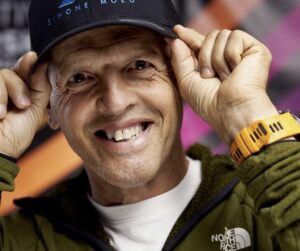These days, we should be reporting on a summit push on Dhaulagiri. The Sherpa team reached Camp 3 yesterday, and the commercial climbers were expected to follow today. According to plan, everyone would summit tomorrow. But things are not going remotely well on Dhaulagiri.
Purnima Srhestha confirmed that the team was retreating from Camp 2 because of “heavy snowfall and the COVID-19 situation.” The Indian photojournalist dismissed that same COVID situation as “nothing serious” two days ago. But the outbreak is now totally out of control.
Some climbers are reportedly refusing to take a test while others are falling sick. Antonios Sykaris started having respiratory issues at the higher camps and has returned to BC to take a COVID test. But he fears the worst.

Antonios Sykaris at Dhaulagiri BC. Photo: Antonios Sykaris
The danger that climbers may reach higher camps, where a rescue is much more difficult, before showing symptoms has put a sudden end to the Dhaulagiri push. It may repeat on Everest, where massive summit waves are expected this week.
Wlademar Kowalewski, Stefi Troguet, Dominic Trastoy, and Moeses Finamoncini reached Camp 3 yesterday and were confident that they could continue. But they have all chosen to retreat. Back in Base Camp, Troguet is feeling well. But she too has just tested positive for COVID.
Meanwhile, in Carlos Soria’s team, Nima Sherpa, Tenjing Sherpa, and Danu Sherpa also tested positive and are in isolation. Today, a helicopter evacuated the team’s cook, Ngati, with more serious symptoms. Soria and his two partners have tried to help combat the spread of the virus, but the rate of contagion continues to rise. As of yesterday, the three Spaniards were all right, and 82-year-old Carlos Soria has received both his mRNA vaccinations.
Both Dhaulagiri and Everest Base Camps do not have access to PCR testing, so are using rapid antigen tests that some climbers have brought. According to the Cochrane Library, which publishes rigorous reviews of multiple studies, antigen tests give false positives just one percent of the time and detect the presence of COVID between 58 and 72 percent of the time.
Rows about the ropes
But the coronavirus is not the only reason for the tension in Base Camp. Carla Pérez told Desnivel that she and Topo Mena were climbing on their own in front partly because they wanted to be on fresh terrain and to make their own decisions, but also because they wanted to avoid conflict. “There were some bad vibes in Base Camp between the Sherpas and some clients who were “not-so-clients”, because they had not paid for the ropes,” she said.
This is a recurrent problem among climbers in a Himalayan base camp. Some pay for a fully serviced expedition, which includes the rope fixing and usually personal Sherpas and oxygen. Others only hire base camp logistics — food, tents, cooks, etc.
In these cases, climbers often pay for the use of ropes or help work on the route. Sometimes, though, the climbers may refuse to pay and claim that they will not use the fixed ropes — although on normal routes, this is unlikely.
Occasionally, the outfitters responsible for the rope fixing are not interested in negotiating a deal. They simply want climbers to pay. The exact cause of the tension on Dhaulagiri remains unclear.
Mena and Pérez’s story
Topo Mena and Carla Pérez said that the going was great until Camp 1 and slightly harder to Camp 2. It then became really difficult until Camp 3, because of very hard ice in places, and definitely tough beyond.
Perez said that they set off from Camp 3 very early on May 8. They progressed slowly because of the difficult, exposed sections. Pérez has summited Everest and K2 without oxygen. Yet even she admitted that climbing alpine style over a mix of hard ice and avalanche-prone slabs that required constant testing was highly taxing, both physically and mentally.
Eventually, Pérez turned around because of the cold. Mena continued until the infamous traverse at 7,700m, but conditions were simply too dangerous. He broke trail in several directions, looking for some acceptably safe direction, but the wind slab on the steep slope was too weak. Eventually, he also turned around.
“Ivan Vallejo [Ecuadorian 14x8000er summiter] had warned us about that traverse,” Pérez said. “Carlos Soria, who knows this mountain so well, told us that conditions were dangerous, and I can only agree with him.”






